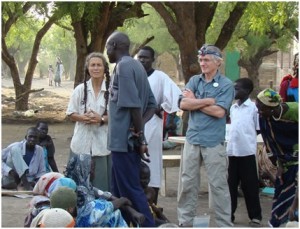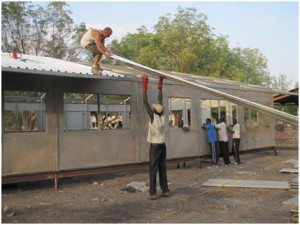By Penny Gage, Rasmuson Foundation Program Associate
Earlier this year, I returned to Alaska after 27 months of U.S. Peace Corps service in Central America. I worked as a community health volunteer in Nicaragua, the second-poorest country in the western hemisphere (after Haiti). The often deplorable living conditions I experienced and the Nicaraguan Ministry of Health’s lack of resources were astounding. Water and vector-borne diseases were rampant, and many people lacked the resources to purchase a simple tube of toothpaste, let alone vital medications. Despite these hurdles, I was inspired by Nicaraguan nurses and doctors who worked long hours trekking through rivers and over mountains in 90-plus degree heat, just to deliver a few drops of polio vaccine or to check-up on a newborn in a far-flung village.
After returning to Alaska, I began to search for local volunteer opportunities. A friend told me of the famed Dr. Jill Seaman and her involvement with the nonprofit, the Alaska Sudan Medical Project (ASMP). Since 1989, Seaman has split her time between Bethel, Alaska working for the Yukon-Kuskokwim Health Corporation, and in the outer reaches of South Sudan in Africa.

In July 2011, after more than 50 years of bloodshed, Africa’s largest country split in two and the Republic of South Sudan became the world’s newest nation. I thought Nicaragua had dire health conditions, but after speaking with Dr. Jack Hickel, founder and board president of ASMP, I realized that South Sudan’s plight is much worse. The nascent country has no health care system and very limited access to infrastructure like running water or electricity. Hickel has a diploma in Tropical Medicine and began his work in Africa in 1982 as a medical missionary. In 2007, at Seaman’s invite, he visited the remote village of Old Fangak, South Sudan.
Hickel was shocked by the desperation and death he saw during his 10 days in Old Fangak. The remote reaches of South Sudan carry some of the worst health statistics in the world. According to ASMP’s website, the infant mortality rate is 1,700 deaths per 100,000 births. Thirty-six percent of children are malnourished and just 10 percent of children have had full childhood immunizations. Due mainly to substandard healthcare, average life expectancy is just 42 years. Upon returning to Alaska, Hickel gathered together friends and supporters and formed ASMP.

Filmmaker and ASMP volunteer Todd Hardesty recently completed a video spotlighting the organization’s work entitled “The Village.” Portions of the video have been posted on ASMP’s YouTube channel. I had the opportunity to see part of the video at a recent ASMP fundraiser in Anchorage and was left speechless by the stunning contrast of the agony of human suffering and the beauty of the country and its people.
ASMP volunteers began the annual journey to South Sudan for the fall/winter building season in October and teams are still departing. Goals for this year include finishing the new health clinic and beginning construction on a second clinic, completion of a water well, and fence construction around the medical compound.
Seaman and Hickel remind me of the Nicaraguan counterparts I worked with in Peace Corps and admired for their perseverance and commitment to public health. I have been inspired to volunteer locally with ASMP and I hope to make the trip myself to Old Fangak next year. ASMP is a wonderful example of Alaskans identifying a need and making change happen. What a big idea from a big state. Alaskans’ incredible work ethic and commitment shine through ASMP’s work.
Much of ASMP’s work is made possible through the Alaska Community Foundation (ACF). Community foundations are one of the fastest growing areas in philanthropy. They are proving that you don’t need to be a millionaire to make a difference, allowing individuals to give in a very personal way to the causes they care about. ACF was established in 1995 and allows organizations and individuals to set-up designated funds where Alaskans like you can donate financially. ACF is compromised of more than 280 component funds and endowments. It manages more than $50 million in assets and grants approximately $5 million a year to charitable projects and nonprofits around the state. The Rasmuson Foundation supports the work of community foundations like ACF, most recently granting $2 million over three years to the Community Asset Building Initiative (CABI) to build community philanthropy in Alaska. While you may not be able to travel to South Sudan and volunteer, you can support ASMP’s work by making an online donation to its designated fund at ACF. Little by little, Alaskans can effect change, even a world away.
Many ASMP volunteers are spending this year’s holiday season in Old Fangak – a testament to their dedication and spirit of service. Alaskans just like you are helping to providing hope in a region that most would ignore or avoid. The tasks at hand for the new country are great and I am heartened to see an organization like ASMP that is leading the way in healthcare, development and service. To learn more, check out ASMP’s Facebook page.
The Rasmuson Foundation invests both in individuals and well-managed 501(c)(3) organizations dedicated to improving the quality of life for Alaskans.
Learn more at rasmuson.org.




